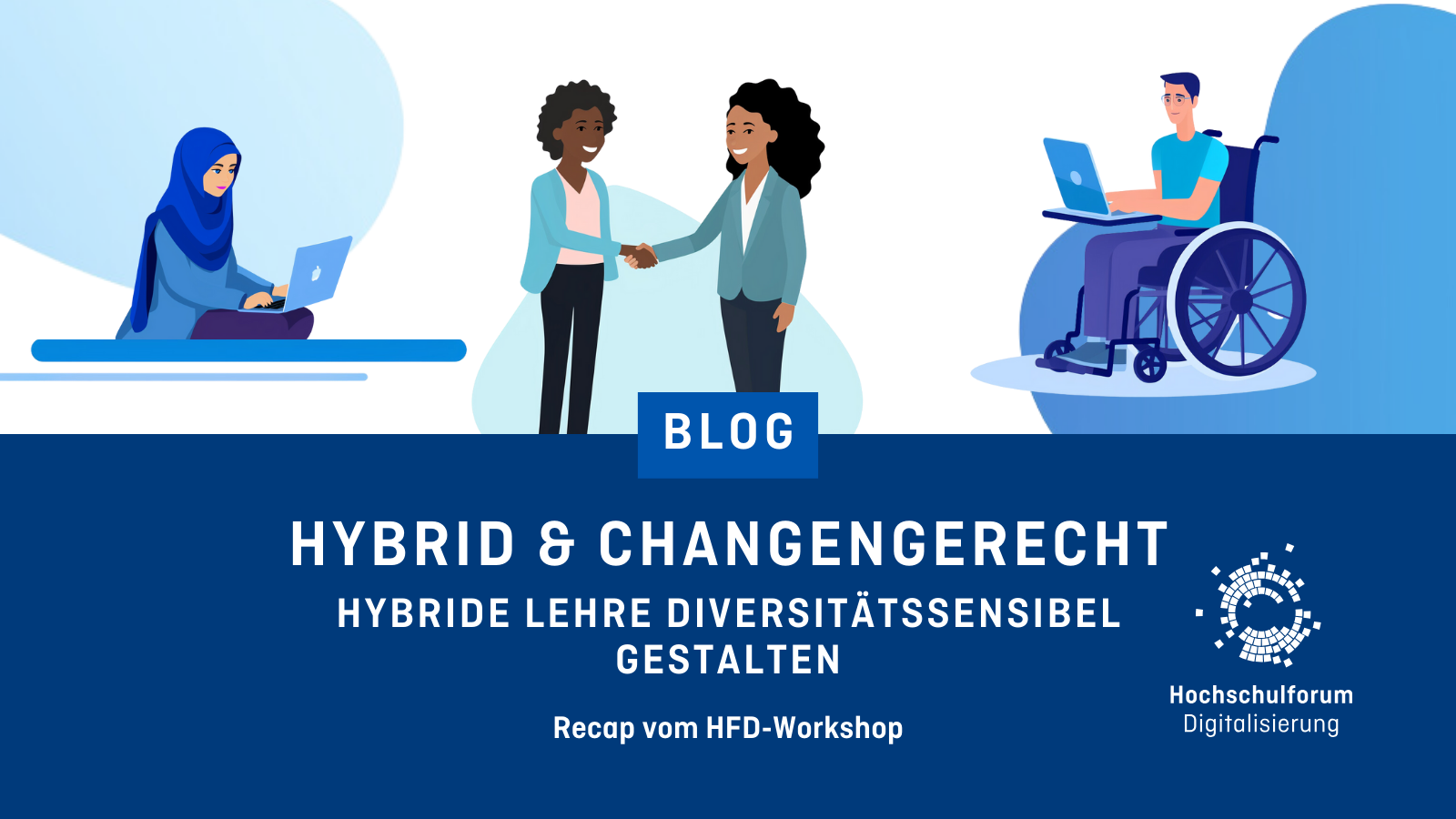Can AI revolutionise higher education? An interview with Claudia de Witt
Can AI revolutionise higher education? An interview with Claudia de Witt
20.01.21
Artificial intelligence in higher education raises great expectations for improved quality of teaching and learning. As a professor of educational theory and media pedagogy at the FernUniversität in Hagen, Claudia de Witt researches methods and applications of AI in studying, teaching and further education. In an interview with Prof. de Witt, Lavinia Ionica, program manager at the Stifterverband, asks what disruptors can be expected in higher education from an educational science perspective and what role artificial intelligence can play here.
This article has been automatically translated using DeepL Translate. Please excuse any mistakes.
Lavinia Ionica: Good afternoon, Ms. de Witt. You have been researching Artificial Intelligence in education for several years. What fascinates you about this field?
Prof. Dr. Claudia De Witt: Yes, for many years I have been working on the significance of digital media for educational processes, on the digitalization of teaching and learning, and thus also on human-computer interaction from an educational science and media education perspective. What fascinates me about this are the innovative potentials associated with technologies, with artificial intelligence, and with which we can shape the future of learning and education as we imagine it. At the FernUniversität in Hagen, I have found an excellent environment for this, where I can couple educational theory requirements with educational technology solutions and contribute with research and development for a contemporary digitized higher education. What particularly fascinates me about Artificial Intelligence is that this technology has the potential to become a kind of personal assistance – in learning and teaching – and can help us to better understand our cognitive and metacognitive abilities, i.e. our thinking, problem solving and decision making.
It is often said that AI can help solve various challenges in higher education. Where do you see the greatest potential?
After all, since the Dartmouth Conference in 1956, artificial intelligence has been listed as a scientific field that deals with machines, robots, and software systems that autonomously perform complex tasks that require human intelligence. And in my opinion, these capabilities can be harnessed for higher education. For example, knowledge-based systems can be applied in combination with machine learning techniques to promote both knowledge acquisition and skill development among students. Artificial intelligence can score open-ended questions in real time and is the basis for intelligent automated assessment; automated scoring can also be used to assess students’ individual contributions, which is known as Automated Essay Scoring. Chatbots answer administrative questions from staff and students on the fly. Educational Data Mining models detect learners’ learning progress, motivation, and metacognitive states over time and enable automated responses in the form of AI sentiment analysis or prediction systems.
Artificial intelligence could be used, for example, to build degree programs and modules along the lines of personalized learning and personalized skills development. Teachers could also be accompanied by a kind of “AI teaching assistant” to help them develop the quality of their teaching.
Adaptive, personalized learning formats that specifically support the diversity of students with their strengths and weaknesses as well as their self-regulation and self-efficacy in their studies and accordingly adapt flexibly and “intelligently” to their individual learning needs are contemporary. AI-supported learning platforms and intelligent assistance systems in the form of recommender or (language) bots can record the specific needs of students, focus on their learning goals, strategies, organization and progress, and provide individual support with suggestions for the further learning process in all study phases. In addition to knowledge-based expert systems, machine learning and learning analytics, academic analytics or educational data mining are used. Hybrid AI systems make sense because, for example, they combine the advantages of machine learning with domain modeling and expert knowledge, and incorporate principles such as explainability, predictability, and traceability.
To successfully deploy artificial intelligence systems in higher education, several criteria must be met. One of them is reliable data. How and where does data arise at universities? And in what quality?
Data at universities is generated at the latest when students enroll. This is followed by entrance surveys, satisfaction surveys, evaluations of events and course materials, and examination data. With the so-called ECTS monitoring, study activities and progress can be measured by determining actual and target ECTS points and tracing study progress. In learning environments, the activities of teachers and learners also generate data. For AI applications, it is imperative that this data be pseudonymized or anonymized in the interest of data protection. The quality of the data for an intelligent system is then particularly dependent on the linking of the data from the different sources. In principle, however, one must always critically question how the data was created and in which situations it will be reapplied.
What kind of information can a digital footprint provide about student behavior?
Students generate data through their logins to the university’s learning environments, through their activities in forums, blogs, quizzes, through their reading and writing activities. These data provide, for example, information about their learning behaviors, learning strategies, media preferences, or communication behaviors. To closely match their individual learning goals, content, pace, and outcomes in interaction with the system, for example, a filtered selection of learning content can be used or good feedback systems are suitable, e.g., to support self-assessment and self-efficacy (“Think about using a different learning strategy”). Checklists are no longer sufficient for personalization; for this we need adaptive (feedback) systems that are able to capture students’ needs and provide individual recommendations for the further learning process.
This then includes, for example, illustrations and visualizations of learning progress; data can be used to make learning needs visible, reporting can be created for students and used for their own assessment of achieved activity levels: “what do you want to be measured on?” After some time, adjustments can be made “your expectations are too high.” And “translanguaging” (automatic translation) helps students assess their language abilities to understand and express their knowledge in their own terms.
I think in the medium term, our existing LMSs will change in this direction. This requires a data-driven understanding of the learning individual. Information about who the learner is, what his/her competencies are, what he/she is currently doing, and what his/her goals are are just some of the information needed to design custom-fit support. Moreover, the approach requires not only an orchestration of technical systems and technologies such as machine learning, learning analytics, recommender systems, etc., but also the involvement of learners as well as teachers, who still need to learn how to use learning analytics dashboards, recommender systems, and personalized adaptations in order to generate optimal benefits for themselves.
In principle, only information that is relevant to students should be collected and used. And if student data is evaluated and used, this should be made transparent and comprehensible, i.e., what data the AI system processes and why it arrives at certain results. This knowledge is in turn the basis for students to proceed in a self-determined and autonomous manner. We must develop artificial intelligence conscientiously and cultivate an ethically justified approach to AI at the university. Clear specifications and evaluation procedures, for example, help to achieve this. AI systems should therefore be explainable AI systems with comprehensible outputs and decisions.

Can you name a specific AI-related scenario that is now a reality in higher education?
In the AI. EDU Research Lab, Niels Pinkwart and his team from DFKI, together with my team from the Department of Educational Theory and Media Education/research focus D2L2 – Digitization, Diversity and Lifelong Learning at the FernUniversität in Hagen, are exploring how educational success can be made more visible not only through degrees, but how methods of artificial intelligence can be used for personalized studies to support students in their personal educational goals and their individual learning processes, their individual acquisition of knowledge and skills, their self-regulation, but also how AI can contribute to improving the individual course of studies and possibly to curricular changes.
For this purpose, we are developing a knowledge-based system consisting of a learner, didactic and domain model. For the domain model, we created ontologies from the study materials that students need to perform their studies and implemented them in Protégé. At the same time, we are creating an Automatic Assessment Tool (AAT) and Intelligent Feedback to Student Exercises (IFSE) using machine learning techniques; the data basis for the Automatic Assessment is legacy exams from several past semesters and a semester-recurring starter quiz implemented in the learning environment. For the IFSE, the domain knowledge is linked to the current exercise system in the Moodle learning environment, so that a dynamic adjustment of the next exercises based on the students’ competence level and a personalized recommendation for further self-learning is made. However, further data collection is currently needed to increase the quality of the Automatic Assessment and to enhance its functionalities.
With the two methods, Expert System and Machine Learning, we link the expert knowledge with the “system knowledge” to provide students in a media pedagogical module with a recommendation system that gives them individual, system-generated feedback on their prior knowledge and supports them in independently working through the study materials for a thematically individually oriented examination performance: a kind of “intelligent” homework assistance. In a further step, the AI.EDU Research Lab has planned the development and research of a recommender system on the level of self-regulated learning in the course of studies by means of Educational Data Mining. In parallel, we are developing ethics guidelines for AI-based distance learning and concepts to raise students’ awareness of the impact of AI methods and to establish transparency.
AI can support educators by providing better insight into student needs. To what extent do you see AI potentially replacing teaching staff entirely?
I don’t think AI will completely replace teaching staff. Technology will certainly relieve instructors of some activities, such as routine corrections of exams or constantly recurring questions. AI systems are indeed able to access an infinite number of databases worldwide in a short time, to suggest relevant sources and current studies to students for their individual study performance more quickly, and even to prepare them if necessary. However, in my opinion, personal contact with the teacher, who knows more than what is written on the Internet, personal support, critical thinking and experience are irreplaceable. Knowledge requires judgment, and only the evaluation, classification and interpretation of data can constitute knowledge. And in this, a good teacher is still better than a machine. Moreover, factors for motivating students such as a teacher’s empathy remain essential.
On the other hand, teacher-centric AI applications can help teachers improve their own teaching. However, in order to use these developments in teaching, new concepts of university didactics are also needed. On the one hand, these concepts must incorporate technological, personalized support for students, and on the other hand, more space must be given to the task of teachers as promoters of critically thinking, self-determined, and socially capable individuals; I am thinking, for example, of a kind of hybrid didactics that takes into account the fact that interaction with technology is becoming increasingly natural and that communication takes place via our language and gestures.
How do you assess the developments: Can we assume in the future that teachers, employees in support structures and administration as well as university administrators and students will be able to deal competently with AI systems?
In my opinion, there is still a long way to go before we get there. University administrators, faculty, and students need to know that we are moving toward a strong “mathematization” of higher education. AI in higher education means being confronted with a datafication of teaching, learning, and research that involves predictability, computability, and control operations. All stakeholders in higher education need to be engaged with the disruptions this entails and be open to the possibilities or aware of the limitations of AI in higher education. This requires competencies about, with, and in spite of AI, as we described in the white paper AI in Higher Education.
How might competency enhancement be advanced in higher education?
A good example of competence enhancement in higher education is the Elements of AI and AI Campus platforms, with their open educational offerings for acquiring competencies about AI. It also seems to me that new degree programs and also smaller educational offerings on AI are emerging at many universities. After all, there is now a growing realization of the need to get smart about AI, Big Data, machine learning, etc., as we are accompanied by AI not only in academia but also in professional contexts and especially in our everyday lives, the technology is “getting closer and closer to us” and we also talk more often about “augmented intelligence” and “augmented learning”.
At universities, for example, students could learn about the possibilities of AI via research-based learning (“inquiry learning”), practice with practical challenges, and develop innovative solutions, i.e., learn about fundamentals and tools in order to then implement their own AI projects in practical phases. Competence development should also be integrated into the curricula of undergraduate degree programs. This aspect should play a role in future accreditations. At the moment, there is already a lot of talk about the need to teach digital skills, but these are not yet being implemented to the necessary extent and at the necessary pace.



 Felix Sühlmann-Faul
Felix Sühlmann-Faul 
 Dr. Hans Pongratz
Dr. Hans Pongratz 
 Dr. Klara Groß-Elixmann
Dr. Klara Groß-Elixmann 